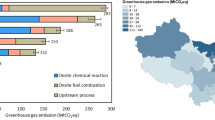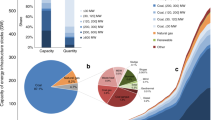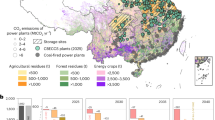Abstract
Symbiotic infrastructure systems facilitate deep decarbonization and efficient water use more than independent improvements in each type of infrastructure. Here we analyse strategies for bridging the coal power and wastewater treatment sectors in China by using sludge and reclaimed water from municipal wastewater treatment as alternative fuels and water sources for coal power generation. We develop a geodatabase covering ~2,400 coal-fired power plants and ~4,200 municipal wastewater treatment plants and conduct an integrated analysis using a customized optimization algorithm and life-cycle assessment. Such infrastructure symbiosis annually offers greenhouse gas (GHG) mitigation of 8.6 Mt CO2 equivalent, equal to 29% and 0.28% of GHG emissions from the wastewater treatment and coal power sectors, respectively. The symbiosis annually conserves 3.0 billion m3 of freshwater, equal to 62% of freshwater consumption by the coal power sector, and provides annual cost savings of 7.5 (3.4–12) billion CNY. Hebei, Shandong, Henan, Jiangsu, Zhejiang, Anhui and Guangdong contribute ~50% of GHG mitigation and ~60% of both freshwater conservation and cost savings due to the proximity of coal power and wastewater treatment plants. Approximately 80% of carbon, water and economic benefits can be achieved via 32% and 44% of all the plant-level linkages for sludge co-combustion and water reuse, respectively. Infrastructure symbiosis provides promising opportunities for both environmental and economic benefits. Policies to boost the establishment of energy–water infrastructure symbiosis would cost-effectively facilitate the achievement of China’s climate and water targets.
This is a preview of subscription content, access via your institution
Access options
Access Nature and 54 other Nature Portfolio journals
Get Nature+, our best-value online-access subscription
$29.99 / 30 days
cancel any time
Subscribe to this journal
Receive 12 digital issues and online access to articles
$119.00 per year
only $9.92 per issue
Buy this article
- Purchase on Springer Link
- Instant access to full article PDF
Prices may be subject to local taxes which are calculated during checkout





Similar content being viewed by others
Data availability
The source data that support all figures and detailed data on CFPPs and WWTPs are provided as Source Data files and Supplementary Data. All data used for this study are provided or available from publicly accessible sources cited. Source data are provided with this paper.
Code availability
The codes that support the findings of this study are available at https://github.com/infraeco/infrastructure.
References
Ferrer, A. L. C., Thomé, A. M. T. & Scavarda, A. J. Sustainable urban infrastructure: a review. Resour. Conserv. Recycl. 128, 360–372 (2018).
Chertow, M. & Ehrenfeld, J. Organizing self‐organizing systems: toward a theory of industrial symbiosis. J. Ind. Ecol. 16, 13–27 (2012).
Lu, Y., Chen, B., Feng, K. & Hubacek, K. Ecological network analysis for carbon metabolism of eco-industrial parks: a case study of a typical eco-industrial park in Beijing. Environ. Sci. Technol. 49, 7254–7264 (2015).
Xu, M. et al. Gigaton problems need gigaton solutions. Environ. Sci. Technol. 44, 4037–4041 (2010).
Pandit, A. et al. Infrastructure ecology: an evolving paradigm for sustainable urban development. J. Cleaner Prod. 163, S19–S27 (2017).
Guo, Y., Tian, J., Chertow, M. & Chen, L. Exploring greenhouse gas‐mitigation strategies in Chinese eco‐industrial parks by targeting energy infrastructure stocks. J. Ind. Ecol. 22, 106–120 (2018).
Unruh, G. C. Understanding carbon lock-in. Energy Policy 28, 817–830 (2000).
Müller, D. B. et al. Carbon emissions of infrastructure development. Environ. Sci. Technol. 47, 11739–11746 (2013).
Jiang, Y. China’s water scarcity. J. Environ. Manage. 90, 3185–3196 (2009).
Holland, R. A. et al. Global impacts of energy demand on the freshwater resources of nations. Proc. Natl Acad. Sci. USA 112, E6707–E6716 (2015).
Wang, X., Wang, X., Huppes, G., Heijungs, R. & Ren, N. Environmental implications of increasingly stringent sewage discharge standards in municipal wastewater treatment plants: case study of a cool area of China. J. Clean. Prod. 94, 278–283 (2015).
Wei, L. et al. Development, current state and future trends of sludge management in China: based on exploratory data and CO2 equivaient emissions analysis. Environ. Int. 144, 106093 (2020).
China Statistical Yearbook of Urban-Rural Development (Ministry of Housing and Urban-Rural Development of China, 2020). https://www.mohurd.gov.cn/gongkai/fdzdgknr/sjfb/tjxx/jstjnj/index.html
Tong, D. et al. Current emissions and future mitigation pathways of coal-fired power plants in China from 2010 to 2030. Environ. Sci. Technol. 52, 12905–12914 (2018).
Zhang, C., Zhong, L. & Wang, J. Decoupling between water use and thermoelectric power generation growth in China. Nat. Energy 3, 792–799 (2018).
World Energy Outlook 2019 (International Energy Agency, 2019); https://www.iea.org/reports/world-energy-outlook-2019
Xu, M., Weissburg, M., Newell, J. P. & Crittenden, J. C. Developing a science of infrastructure ecology for sustainable urban systems. Environ. Sci. Technol. 46, 7928–7929 (2012).
Hu, W., Guo, Y., Tian, J. & Chen, L. Energy and water saving potentials in industrial parks by an infrastructure-integrated symbiotic model. Resour. Conserv. Recycl. 161, 104992 (2020).
Xi calls for bolstering confidence, jointly addressing global challenges at UNGA. Xinhua (21 September 2021); http://english.www.gov.cn/news/topnews/202109/22/content_WS614a816dc6d0df57f98e0a56.html
Guidelines on Facilitating the Wastewater Reuse (National Development and Reform Commission of China, Ministry of Science and Technology of China, Ministry of Industry and Information Technology of China et al. 2021); https://www.ndrc.gov.cn/xwdt/tzgg/202101/t20210111_1264795_ext.html
Plans for Facilitating Co-combustion of Coal and Biomass (National Energy Administration of China, Ministry of Environmental Protection of China, 2017); http://zfxxgk.nea.gov.cn/auto84/201712/t20171204_3065.htm
Announcement of Pilot Projects for Co-combustion of Coal and Biomass (National Energy Administration of China, Ministry of Ecology and Environment of China, 2018). http://drc.gd.gov.cn/gkmlpt/content/1/1060/post_1060827.html#830
Guo, S., Huang, H., Dong, X. & Zeng, S. Calculation of greenhouse gas emissions of municipal wastewater treatment and its temporal and spatial trend in China. Water Wastewater Eng. 45, 56–62 (2019).
Zhang, C. et al. Field test and numerical simulation for co-combustion of sludge in a 100 MW coal fired boiler. J. Combust. Sci. Technol. 21, 114–123 (2015).
Guo, Y., Tian, J., Chertow, M. & Chen, L. Greenhouse gas mitigation in Chinese eco-industrial parks by targeting energy infrastructure: a vintage stock model. Environ. Sci. Technol. 50, 11403–11413 (2016).
Nordhaus, W. Estimates of the social cost of carbon: concepts and results from the DICE-2013R model and alternative approaches. J. Assoc. Environ. Resour. Econ. 1, 273–312 (2014).
Luo, T. & Hu, J. Techno-economic analysis of reclaimed water pipeline materials. Shanxi Archit. 40, 132–133 (2014).
Code for Design of Thermal Power Plant (GB50660-2011) (Ministry of Housing and Urban-Rural Development of China, 2011).
Cui, R. Y. et al. A plant-by-plant strategy for high-ambition coal power phaseout in China. Nat. Commun. 12, 1468 (2021).
Standards for Construction of Municipal Wastewater Treatment Projects (Ministry of Housing and Urban-Rural Development of China, 2001).
Wang, P. Incineration and disposal of dehydrated sludge from municipal wastewater treatment plants. Sci. Technol. Vision 11, 227–228 (2020).
Li, D. et al. Investigation and application of sewage sludge co-combustion in a 300 MW coal-fired boiler. Zhejiang Electr. Power 38, 109–114 (2019).
Liu, Y., Teng, J., Su, Y., Kang, J. & Zhang, Y. Research on pollutants emitted from dried sludge blending combustion in coal-powder boiler. Chin. J. Environ. Eng. 8, 4969–4976 (2014).
Hao, X., Chen, Q., Li, J. & Jiang, H. Unnecessary worry about pollutants in off-gases of sludge incineration. China Water Wastewater 35, 8–14 (2019).
Statistical Data of Electricity Industry Development 2016 (China Electricity Council, 2017); http://www.chinayearbook.com/yearbook/item/1/197766.html
Basic Information Tables for 600 MW-level Thermal Power Generating Units (China Electricity Council, 2012); http://www.chinapower.com.cn/kjfwduibiao/20160422/4817.html
Basic Information Tables for 100–225 MW-level and 300 MW-level Thermal Power Generation Units (China Electricity Council, 2013); http://www.chinapower.com.cn/kjfwduibiao/20160422/4824.html
Lists of Desulfurization and Denitrification Facilities of Coal-fired Power Generation Units (Ministry of Environmental Protection of China, 2014); https://www.mee.gov.cn/gkml/hbb/bgg/201407/t20140711_278584.htm
Manual of Power Generation Units in China (China Electricity Council, 2013).
Catalog of Municipal Wastewater Treatment Plants in 2014 (Ministry of Environmental Protection of China, 2015); https://www.mee.gov.cn/gkml/hbb/bgg/201506/t20150609_303209.htm
Manual of Industrial Pollution Source Coefficients (Ministry of Environmental Protection of China, 2010).
Manual for Pollutant Emission Accounting Methods and Emission Factors (Ministry of Ecology and Environment of China, 2021); https://www.mee.gov.cn/xxgk2018/xxgk/xxgk01/202106/t20210618_839512.html
Liu, F. et al. High-resolution inventory of technologies, activities, and emissions of coal-fired power plants in China from 1990 to 2010. Atmos. Chem. Phys. 15, 13299–13317 (2015).
Zhang, C., Zhong, L., Fu, X., Wang, J. & Wu, Z. Revealing water stress by the thermal power industry in China based on a high spatial resolution water withdrawal and consumption inventory. Environ. Sci. Technol. 50, 1642–1652 (2016).
IPCC Climate Change 2013: The Physical Science Basis (eds Stocker, T. F. et al.) (Cambridge Univ. Press, 2013).
Baidu Map Open Application Programming Interface (Baidu, 2022); https://lbsyun.baidu.com/
Code for Urban Water Supply Engineering Planning (GB50282-2016) (Ministry of Housing and Urban-Rural Development of China, 2016).
Pilot Scheme of Water Resource Tax Reform (Ministry of Finance of China, State Taxation Administration of China, Ministry of Water Resources of China, 2016); http://www.chinatax.gov.cn/n810341/n810755/c2132428/content.html
Rebitzer, G. et al. Life cycle assessment, part 1: framework, goal and scope definition, inventory analysis, and applications. Environ. Int. 30, 701–720 (2004).
ISO 14040:2006 Environmental Management—Life Cycle Assessment—Principles and Framework (International Standardization Organization, 2006); https://www.iso.org/obp/ui#iso:std:iso:14040:ed-2:v1:en
Acknowledgements
L.C., J.T., Y.G., W.H. and Y.L. acknowledge the National Natural Science Foundation of China number 41971267 and National Social Science Foundation of China number 18ZDA046. D.L.M. acknowledges funding from the Ma Huateng Foundation to Princeton University. Y.G. acknowledges the support from the Schmidt Science Fellows in partnership with the Rhodes Trust. The funders had no role in study design, data collection and analysis, decision to publish or preparation of the manuscript.
Author information
Authors and Affiliations
Contributions
Y.G., D.L.M., J.T. and L.C. conceived the research idea and designed the study; Y.G., Y.L. and W.H. compiled the geodatabase on China’s coal power plants and wastewater treatment plants and the distance matrix between them; Y.G. designed the scenarios and optimization algorithm; Y.G. conducted the life-cycle assessment and cost–benefit analyses; Y.L. and W.H. contributed to the assessment framework and engineering analyses; Y.G., D.L.M., J.T. and L.C. analysed the results; Y.G., D.L.M. and L.C. wrote the paper with contributions from all authors.
Corresponding authors
Ethics declarations
Competing interests
The authors declare no competing interests.
Peer review
Peer review information
Nature Sustainability thanks Kejun Jiang, Chao Zhang and the other, anonymous, reviewer(s) for their contribution to the peer review of this work.
Additional information
Publisher’s note Springer Nature remains neutral with regard to jurisdictional claims in published maps and institutional affiliations.
Supplementary information
Supplementary Information
Supplementary Notes 1–2, Figs. 1–5, Tables 1–9 and References.
Supplementary Data
Source data for supplementary figures and the inventory of coal power and wastewater treatment plants.
Source data
Source Data Fig. 1
Detailed provincial-level results.
Source Data Fig. 2
Detailed grid-level results.
Source Data Fig. 3
Detailed provincial-level results.
Source Data Fig. 4
Detailed linkage-level results.
Source Data Fig. 5
Detailed linkage-level results.
Rights and permissions
Springer Nature or its licensor (e.g. a society or other partner) holds exclusive rights to this article under a publishing agreement with the author(s) or other rightsholder(s); author self-archiving of the accepted manuscript version of this article is solely governed by the terms of such publishing agreement and applicable law.
About this article
Cite this article
Guo, Y., Mauzerall, D.L., Lyu, Y. et al. Benefits of infrastructure symbiosis between coal power and wastewater treatment. Nat Sustain 5, 1070–1079 (2022). https://doi.org/10.1038/s41893-022-00963-z
Received:
Accepted:
Published:
Issue Date:
DOI: https://doi.org/10.1038/s41893-022-00963-z



